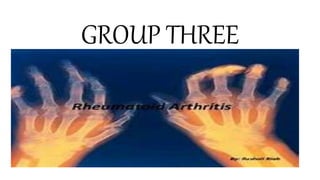
GROUP THREE.pptx
- 2. MEMBERS • OWUSU DARKO GODFRED • MICHAEL GYAMFI • AMPOFOWAA JANET
- 3. OUTLINE • Introduction • Causes/Etiology • Signs and symptoms • Pathophysiology • Diagnosis • Risk factors • Prevention • Treatment
- 4. WHAT IS RHEUMATOID ARTHRITIS Rheumatoid arthritis is an autoimmune disease in which the normal immune response is directed against an individual's own tissue. It is a chronic inflammatory disorder of unknown etiology that involves synovial joints.
- 5. CAUSES/ETIOLOGY OF RHEUMATOID ARTHIRITIS • The triggering factors are unknown and could be for many reasons which include: • Age - affects adults > 40 years • Obesity increases risk of developing arthritis • Family history of rheumatoid arthritis increases risk • Cigarette smoking • Stress and trauma [lower body immunity] • Nutritional deficiencies [poor nutrition compromises the immunity system].
- 6. SIGNS AND SYMPTOMS • Fatigue • Pain • Anxious mood • Morning stiffness • Joint pain
- 7. OTHER SIGNS AND SYMPTOMS • Chest pain when taking a breath (pleurisy) • Dry eyes and mouth (Sjogren syndrome) • Eye burning, itching, and discharge. • Nodules under the skin (usually a sign of more severe disease) • Numbness, tingling, or burning in the hands and feet
- 8. PATHOPHYSIOLOGY • Rheumatoid arthritis is a systemic disease but the most characteristic lesions are seen in the synovium. • The synovium is engorged with new blood vessels packed full of inflammatory cells. • The pathological changes, if unchecked, proceed in four stages.
- 9. STAGES Stage 1 (PRE-CLINICAL STAGE) Before RA becomes clinical apparently the immune pathology is already beginning.
- 11. STAGE 3 DESTRUCTION • Persistent inflammation causes joint and tendon destruction.
- 12. STAGE 4 DEFORMITY • The combination of articular destruction, capsular stretching and tendon rupture leads to progressive instability and deformity of the joints.
- 14. DIAGNOSIS Blood test: Erythrocyte sedimentation rate (ESR) X-ray Magnetic resonance imaging (MRI) Arthrocentesis
- 16. RISK FACTORS • Family history of RA (genetic predisposition) • Age between 30 and 60 • Being female (70 percent of sufferers are women) • Smoking
- 17. PREVENTION • There is no known way of prevention. However, one can avoid the risk factors such as: • Avoid smoking • Weight management through exercise and proper diet • Limit exposure to environmental pollutants
- 18. TREATMENT • Medication- using of Anti rheumatic drugs. Example Methotrexate, leflunomide etc. • Orthotic braces • Physiotherapy • Surgical treatments : tendon repair, total joint replacement.
- 20. Thank You
Notes de l'éditeur
- including the joints, tendons, and bones, resulting in inflammation and destruction of these tissues Autoimmune disease happens when the body's natural defense system can't tell the difference between your own cells and foreign cells, causing the body to mistakenly attack normal cells which means that your immune system attacks healthy cells in your body by mistake, causing inflammation (painful swelling) in the affected parts of the body Chronic inflammation is also referred to as slow, long-term inflammation lasting for prolonged periods of several months to years
- Fatigue is a feeling of constant tiredness or weakness and can be physical, mental or a combination of both. Pain is an unpleasant sensory and emotional experience associated with actual potential tissue damage. Anxiety is an emotion characterized by feelings of tension, worried thoughts, and physical changes Morning stiffness ; slowness or difficulty moving the joints when getting out of bed or after staying in one position too long
- A nodule is a growth of abnormal tissue under the skin Tingling …….. it's a sign that a nerve is irritated and sending extra signals
- Stage 1 is early-stage RA. Many people feel joint pain, stiffness, or swelling. During stage 1, there’s inflammation inside the joint. The tissue in the joint swells up. For example, when there is stage 1 RA in the hands, a person may feel stiffness and pain in the finger joints and knuckles. These sensations can usually disappear with movement.
- Synovitis (or synovial inflammation) is when the synovium of a joint becomes inflamed (swollen). SYNOVITIS Inflammation (swelling, pain, and warmth) of a synovial membrane, which is a layer of connective tissue that lines a joint
- Once RA progresses to stage 3, experts consider it severe. At this point, the damage extends to the cartilage, and bone destruction progresses. Since the cushion between bones wears away, the bones rub together. There may be more pain and swelling. Some people may experience muscle weakness and more mobility loss.
- At stage 4, there’s no longer inflammation in the joint. This is end-stage RA, when joints no longer work as they should. In end-stage RA, people may still experience pain, swelling, stiffness, and mobility loss. There may be lower muscle strength. The joints may experience destruction, and the bones may fuse (ankyloses Depending on the progression and location of the end-stage RA, a person may lose the function of their hands or have a difficult time bending their knees or flexing their hips
- Blood test: Blood test to test for Rheumatoid factor, anti-CCP antibodies. Erythrocyte sedimentation rate (ESR): Erythrocyte sedimentation rate test to determine presence of inflammatory mediators. X-ray: To identify the extent of damage to the joints. Magnetic resonance imaging (MRI): Helps to find out the severity of the disease condition. Arthrocentesis: A procedure during which a sterile needle is used to withdraw joint fluid to determine the cause of symptoms.